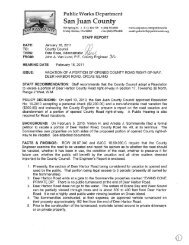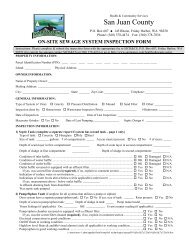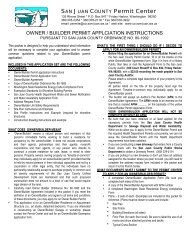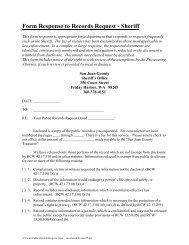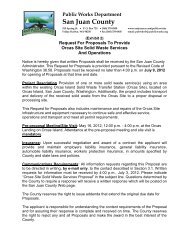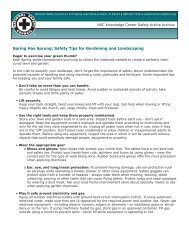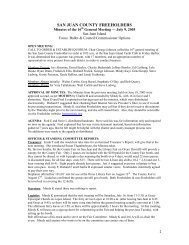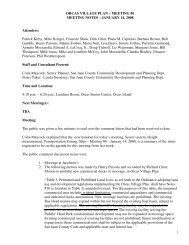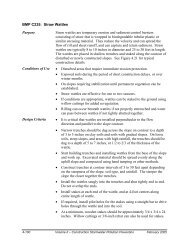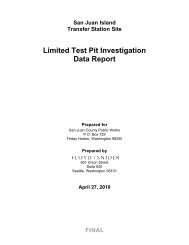Ordinance No._____- 2012 AN ORDINANCE ... - San Juan County
Ordinance No._____- 2012 AN ORDINANCE ... - San Juan County
Ordinance No._____- 2012 AN ORDINANCE ... - San Juan County
You also want an ePaper? Increase the reach of your titles
YUMPU automatically turns print PDFs into web optimized ePapers that Google loves.
Table 3.12<br />
Additional Protection Requirements and Recommendations for Specific Animals<br />
Page 47 of 56<br />
Ord. ____-<strong>2012</strong><br />
Species Habitat Description Protection Requirements (required unless<br />
noted as a recommendation)<br />
(For additional information see<br />
http://wdfw.wa.gov/hab/phslist.htm)<br />
Amphibians<br />
Sharp-tailed<br />
Snake<br />
Western toad<br />
Birds<br />
American dipper<br />
Black<br />
Oystercatcher<br />
Chipping sparrow<br />
Common<br />
nighthawk<br />
Relatively open, moist, woodlands,<br />
particularly near streams and secluded,<br />
south facing, rocky slopes. They spend<br />
most of the time under rocks and rotting<br />
woody material. Primary food source is<br />
slugs. Use communal egg laying sites in<br />
cracks between rocks, underground or<br />
in clumps of grass roots.<br />
Live near springs, streams, meadows<br />
and woodlands, especially those within<br />
approximately 500 meters of ponds or<br />
wetlands. Feed on insects. Preferred<br />
breeding sites are water bodies with<br />
with shallow, sandy bottoms. After<br />
breeding they disperse into terrestrial<br />
habitats such as forests and grasslands,<br />
preferring damp conditions. Spend<br />
much time underground, often in small<br />
mammal burrows, beneath logs, and<br />
within rock crevices. Hibernate in<br />
burrows over the winter.<br />
Shorelines of perennial streams and<br />
lakes and ephemeral streams that flow<br />
into them.<br />
These birds nest on the ground above<br />
the rocky intertidal zone in areas<br />
without predatory mammals.<br />
Savannas, orchards, low-density<br />
residential areas.<br />
Rocky balds and flat areas with minimal<br />
vegetation<br />
In areas with sharp tailed snakes:<br />
●Prevent soil-disturbing activities.<br />
●Retain rocks and down wood.<br />
●Avoid predation by domestic cats.<br />
In areas with western toads:<br />
●Establish wetland buffers based on a Water<br />
Quality-Sensitivity Rating of “High” and a<br />
Habitat Importance-Sensitivity Rating of<br />
“High”. Protect buffers in accordance with<br />
SJCC 18.30.150. Protect wetlands and their<br />
buffers.<br />
●Prevent soil-disturbing activities.<br />
●Prevent pollution of runoff.<br />
●Retain rocks and down wood.<br />
●Avoid or minimize the introduction of aquatic<br />
predators (e.g. fish) into ponds and lakes.<br />
●Prevent disturbance of active nesting areas<br />
during the spring.<br />
●Maintain perennial flow in all streams<br />
currently with perennial flow.<br />
●Maintain buffers along streams and lakes.<br />
●Maintain forage fish populations and protect<br />
kelp and eelgrass beds in conformance with the<br />
Unified Development this cCode.<br />
●Discourage human presence near active<br />
nesting areas during the spring.<br />
●Prevent disturbance of active nesting areas<br />
during the spring.<br />
●Maintain mix of open land and wooded areas.<br />
●Prevent disturbance of active nesting areas<br />
during the spring.<br />
N:\L<strong>AN</strong>D USE\LONG R<strong>AN</strong>GE PROJECTS\PCODES-11-0004 CAO FWHCAs\Docs from PC and CC\FWHCAOrdCC_<strong>2012</strong>-10-26.doc



